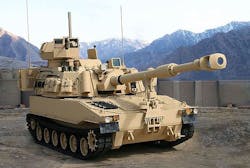Army to buy 30 reconditioned and upgraded 155-millimeter self-propelled artillery pieces
Officials of the Army Contracting Command-Tank and Automotive in Warren, Mich., announced a $235.3 million contract modification Friday to the BAE Systems Platforms & Services segment in York, Pa., for 30 M109A7 self-propelled howitzers and 30 M992A3 carrier, ammunition, tracked vehicles.
The M109A7 is the newest M109 version for U.S. military service. Formerly known as the M109A6 Paladin Integrated Management (PIM) version, the M109A7 uses the existing main armament and cab structure of a Paladin M109A6 self-propelled cannon, and replaces the vehicle’s chassis components with modem components common to the M2A3 Bradley Fighting Vehicle.
The goal of these upgrades is to enable the M109A7 artillery to keep up with the Army's fast-moving armored brigade combat team (ABCT) alongside the M1 Abrams main battle tank and the M2 Bradley armored personnel carrier.
The M109A7 program enhances the reliability, maintainability, performance, responsiveness, and lethality of the M109A6 Paladin self-propelled howitzer and M992A2 Field Artillery Ammunition Support Vehicle’s (FAASV).
The M109A7 is the primary indirect fire support system for the armored brigade combat teams. Its improved chassis provides greater survivability and commonality with existing ABCT armored combat vehicles. The program seeks to reduce maintenance costs by replacing obsolete components.
The M109A7 capitalized on today's most advanced technology, including a state-of-the-art digital backbone and power generation capability, BAE Systems officials say.
Legacy M109 howitzers first are shipped to the Anniston Army Depot, Ala., where they are disassembled to provide cab structures, overhauled gun and cannon assemblies, and other vehicle components, and re-shipped to BAE Systems combat vehicle factory in York, Pa., for final assembly.
Related: Army taps Raytheon to build another 209 Excalibur heavy artillery smart munitions
The M109A7's on-board power systems harness technologies originally developed for the cancelled Non-Line-of-Sight Cannon. It has an electric drive that is faster than the previous hydraulic system, and has an automatic rammer for consistent velocities and accuracy.
The newest version of the M109 self-propelled cannon has a 600-volt power system to accommodate additional armor and future networking technologies. The gun can sustain a one round per-minute rate of fire and a maximum rate of fire of four rounds per-minute.
Friday's contract modification is for low-rate initial production option 2. The first M109A7 low-rate production deliveries began last April. Ultimately Army leaders want to buy 133 of the self-propelled cannons. A full-rate production decision is set for early 2017.
On this contract modification BAE Systems will do the work in York, Pa., and Elgin, Okla., and should be finished by June 2018. For more information contact BAE Systems Platforms & Services online at www.baesystems.com, or the Army Contracting Command-Tank and Automotive at www.tacom.army.mil.

